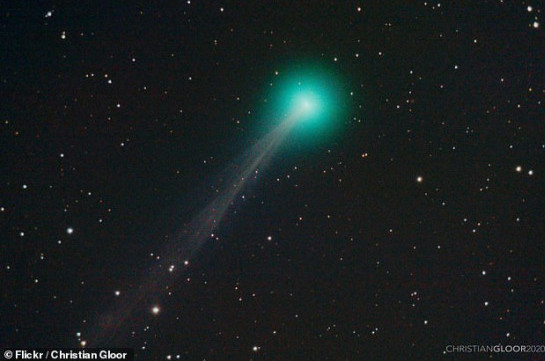
15/05/2020 15:08
Green-tinged Comet Swan with an 11 million-mile-long tail flies past Earth on its way to the Sun
Comet Swan and its 11 million mile long tail will be visible in the night sky from tonight and you may be able to see it with the naked eye, astronomers say.
The ball of ice, discovered in April by astronomer Michael Mattiazzo from Australia, has already passed the Earth but is getting brighter as it approaches the Sun, The Daily Mail reports.
It will be best viewed from the southern hemisphere, but those in the northern hemisphere will still be able to see it low on the horizon in the pre-dawn hours.
Swan is currently about 53 million miles from the Earth and is expected to be a 'significant' comet in terms of visibility, according to the European Space Agency.
The green-tinged ball of ice and dust visits the inner part of the solar system once every 11,597 years and has a long blue tail stretching 10 million miles behind it.
Currently moving from the southern to the northern skies, it is just faintly visible to the naked eye, but current estimates suggest that, by the end of May, it could be significantly brighter – if it survives that long.
The more material ejected from the comet as it warms up on its way towards the sun, the more sunlight it reflects and the more visible it becomes.
Comets are fragile and often break apart as they approach the Sun - this happened to Comet ATLAS last month after it was also predicted to become very bright.
Comet Swan is now entering the 'danger zone' and will reach its closest point to the Sun on 27 May – at this time, the solar heating will be at its maximum.
If it survives it will become more visible in the northern hemisphere, switch to the evening sky and be higher above the horizon, astronomers predict.
Swan will be visible from tonight and through the weekend as a faint and fuzzy dot with a long tail - you'll get a clearer view with binoculars or a small telescope.
Mattiazzo spotted the icy rock, that originated in the outer solar system , while inspecting images on a computer - rather than looking through a telescope.
The images were captured by the Solar Wind Anisotropies (SWAN) instrument on the European Space Agency and NASA Solar and Heliospheric Observatory (SOHO).








